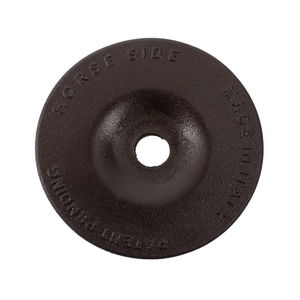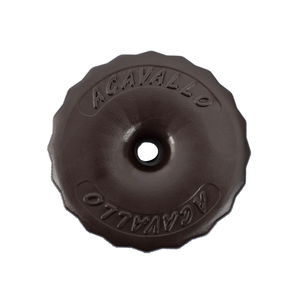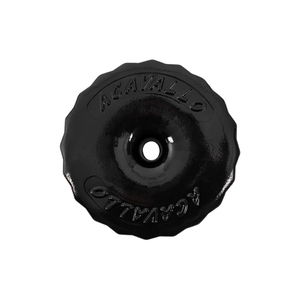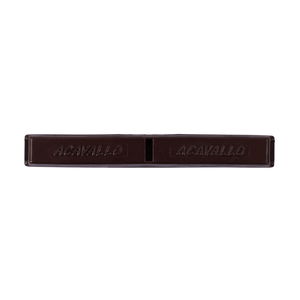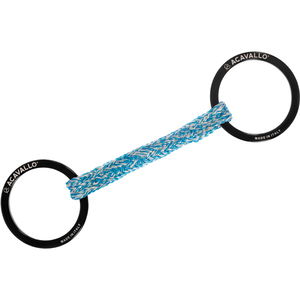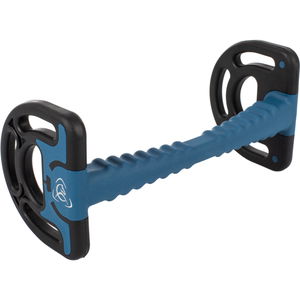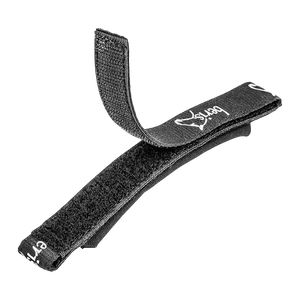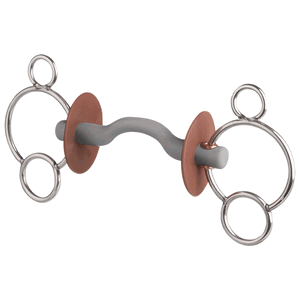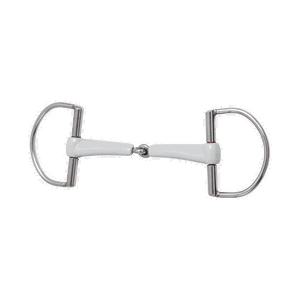Horse Bits
(742)The horse bit is a component of the bridle. The bit rests in a toothless gap in the horse's mouth and is attached to the cheekpiece of the snaffle. This,... LEARN MORE
Frequently asked questions about Bits
Horses are as different and diverse as people, which is why everyone should know and observe their own horse closely. Once the correct size and thickness of the bit have been determined, the rider is now faced with finding the right shape with the correct snaffle rings. The starting point for many trainers is the single or even the double broken water snaffle. In general, if you determine that the bit is not suitable for the respective horse, you should identify the problem and try others that might adress that particular area. There is no right or wrong, but it should be targeted individually at the rider and horse.
There are many ways to determine the correct size of the bit. Several manufacturers now offer small templates or other aids that make it very easy to determine the size of the bit. But even if you don't have such products at hand, you can determine the right bit size with a little trick. Take a slightly longer bit and place it in the horse's mouth. The points on the left and right - or just on one side - get "marked" and measured later. Now add half a centimetre to this measurement. Have an expert help you to determine the correct size or ask a professional if necessary.
Young horses have not yet seen many bits and therefore often still have a very delicate and sensitive mouth. Since there is no general answer to this question, as every horse reacts differently, there is only a rough guideline and recommendation to use a double broken bit with stable side pieces, to prevent the bit from lying too unsteadily in the mouth and at the same time to minimise the pressure on the bars. Additionally, all kinds of water snaffles are suitable as well, as these represent an all-round bit par excellence. Especially with young horses, the motto should be "keep it as simple as possible". If it doesn't work, you can always change the bit.
Sensitive horses benefit from soft and gentle bits. For this type of horse, the material often plays an equally important role as the shape, with the result that one horse prefers leather bits and another prefers plastic or metal bits. There is now a wide variety of materials and alloys that enable horses that are allergic to metal, for example, to wear a bit. The motto of a simple and gentle bit also applies to sensitive horses.
Horses are as different and diverse as people, which is why everyone should know and observe their own horse closely. Once the right size and thickness of the bit have been determined, the rider is now faced with the task of finding the right shape with the right snaffle rings or similar. For many trainers, the starting point is a single or double broken water snaffle. If, in the course of time, the rider or an experienced trainer feels that the bit is not suitable for the horse in question, the problem can be addressed individually and a different bit can be tried out. There is no right or wrong way to do this, however, it is important to pay attention to the intuition of the rider and the experience of the trainer.
Contrary to what many people would like to think, bits also have a part for the left and right side. A close look often suffices to find out which side has to be buckled on which hand. Information about signs or similar can be found quickly on the manufacturer's website. If, however, there is no sign or marking on the bit to indicate the direction of buckling, simple common sense is often sufficient. Therefore take one end of the bit in your left hand and the other in your right. If you now put your fists together, the bit (if it is broken) should escape upwards. Once you have determined where the right end is and where the left end is, the bit is buckled into the noseband exactly as your own fists have indicated. The left side of the bit gets placed into the left buckle of the noseband. When buckling in the noseband, one always speaks of the left hand, that is, the left side of the horse. The whole procedure is repeated on the other side. If there is still any uncertainty, an experienced trainer should be consulted to ensure the horse's safety.
Besides the different shapes and designs, there are the two indicators of the length and thickness of a bit. The length can be found out quickly, as water snaffles or snaffles that are similar in structure should always be half a centimetre longer than the width of the horse's mouth. However, it is also important to note that bits that are buckled further down in the mouth, such as the curb bit, should be bought in a shorter length, as the horse's mouth narrows towards the front. The thickness of the bit remains important, but this is not so easy to determine, which is why it is advisable to consult an experienced trainer. A bit that is too thick can increase the pressure in the mouth considerably, whereas a bit that is too thin has a very sharp effect on the surrounding area. Depending on the level of training of the rider, the horse and the breed-specific characteristics of its mouth, a decision can be made between bit thicknesses of 10mm-18mm.
When horses are very impetuous or strong during work, they usually come against the bit and thus reduce the rider's influence and control. If this happens every day during normal work on the home ground, the choice of bit and one's own riding style should be carefully checked. Often pressure creates counter-pressure, which then builds up until the rider resorts to harder means and uses a sharper bit. However, if you have a horse that runs hot, especially on the course, and you want more control, then straight bar bits or pelhams are suitable, as they exert more pressure on the palate or the bars. Bits that work with a leverage effect, such as the Pelham, continue to create pressure on the neck, creating numerous pressure points. However, it is important to emphasise again that the cause of the "being strong" should first be found out before resorting to sharper bits, which in the worst case will only make the horse even stronger.
What kinds of different horse bits are there?
Some of the most diverse materials are used in the manufacture of horse bits. Snaffle bits can be made entirely of titanium, carbon, Sensogan or steel, but mixed materials are also widely used. For example, the mouthpiece can be made of flexible plastic with stainless steel, while the rings, in turn, can be manufactured from steel. Both the mouthpiece and the bit ring are available in various shapes in Fundis’ Online Shop, depending on preference, as well as anticipated use. Apart from that, we offer special bits, such as corrective bits designed to help tongue problems. They are anatomically shaped, so the tongue can lie free. They can be used for a period of two to three weeks.
Basic categories of bit types:
- Unjointed bits: the horse bit consists of a solid bar
- double broken: the bit is broken several times and consists of several bars connected by means of hinges.
- single broken: the mouthpiece consists of two bars connected by means of a hinge.
Hackamore, full cheek snaffle and more
Our online shop carries are large selection of qualitative, high-quality horse bits, so the right bit can be found for practically every riding style. We do not carry western bits.
Bit types available in our collection:
- Baucher bits It's solid attachment to the bridle gives the Baucher bit a more precise effect than the snaffle bit, for example. This type of bit is rather mild, since it rests stably in the horse’s mouth.
- Nathe bits: Nathe bits are particularly kind to the horse's mouth thanks to their special, anti-allergen plastic from which they are manufactured, and are therefore especially suited to sensitive horses with tender jaws. The plastic is realistic, temperature-neutral and contains no softening agents.
- Gag bits: A gag bit is provided with special, looped eyelets through which a gag bit cord or cord may be passed, and then attached to the bridle or the reins, as the case may be.
- D ring bit: The D ring bit makes for a sustainably calm and neutral position in the horse’s mouth. This makes the bit perfect for inexperienced, young horses. Particularly inexperienced riders benefit from using D ring bridles, since they measure out force application better where the rider has uneasy hands.
- Hackamore: The Hackamore is a horse bit used exclusively by experienced riders. In most cases, it’s used as a bitless bridle to spare the horse’s mouth. The bit provides its benefit through its effect on the horse’s nose.
- Curb bit, curb bits for dressage and curb bits for jumping: The Curb bit – or the curb bit for jumping, in the particular case – is a mouthpiece that is not broken, but which is equipped with shanks nevertheless. It guarantees even distribution of the rein's force on the bit and neck and facilitates an intense though subtle effect on the horse.
- Plastic bits or rubber bits: Rubber bits are perfect for any horse that simply won't tolerate a metal bit in its mouth. Optimally, a metal core should be processed to prevent wear through.
- Leather bits: Bits made from leather fit well in the horse’s mouth and are relatively soft and flexible. They are quite high-maintenance and relatively short-lived, however.
- Eggbutt snaffle bits: An eggbutt snaffle bit is perfect for preventing injuries to the horse’s mouth. The eggbutt snaffle locks the bit. It is nevertheless a harder bit, since a greater leverage effect is exercised on the horse's mouth at the same time.
- Pelham bit: The Pelham bit bis made of short (baby pelham) or long sides. Depending on the length of the sides, a greater or lesser leverage effect is produced. You can ride the bit either with two reins, fastened by means of an upper and lower ring, respectively, or with just one rein, which is attached to the strap between the two rings and which comparatively reduces the application of force.
- Full Cheek snaffle: A Full Cheek snaffle is a derivative of the eggbutt snaffle. It is ideally suited for horses that are having problems being guided by the rider, or where the horses are simply young and inexperienced. The lateral shanks prevent the bit from being drawn through the horse's mouth. The cheek snaffle is perfect for training, longeing, carriage rides, etc.
- Special bits: Special bits include Corrective bits, for example, which are oriented towards the particular needs of the horse.
- Bridoon: As soon as the use of a curb bit comes into question, a bridoon should come into play. The bridoon provides additional protection for the horse's sensitive mouth.
- Loose ring bit: The loose ring bit is the classic, all-round bit that can be used in just about any field of activity. The power which the rider passes on through the reins to the bit has a direct effect on the place in the horse's mouth upon which the bit rests.
- 3 ring bit: A 3-ring bit is also known as a pessoa. It is precisely with boisterous horses that this bit finds it best use, since they can be controlled better with less effort using the 3-ring bit.
What should I look for in a horse bit?
The horse bit rests in a toothless gap in the horse's mouth and must be adjusted to the horse to prevent risk of injury. If the horse bit is too long, it may slip. If it's too short, on the other hand, it can cause contusions of the skin folds in the corner of the animal's sensitive mouth. As a rough guideline, it can be said that the length of the horse bit chosen should exceed the breadth of the horse’s mouth on both sides by half a centimetre. The distance between the bit rings is generally used to measure this. The thickness of the bit plays an additional, significant role. If the horse bit is too thick, then your horse won't be able to close its mouth properly under certain circumstances without exerting unpleasant pressure on certain points. Here, you should use your own discretion to determine which horse bit comes into question. The most common bits are 16mm long; however, there are bits as short as 10mm, while others can measure up to 23mm in length.
Generally speaking, it is important to involve the horse in the decision. Only when the animal is feeling at ease can the communication between rider and horse function without any complications. If the animal reacts unusually to the bit, then it is recommended that you choose an alternative.
- Have you adjusted the right fit?
- Length
- Thickness
- Does the horse agree with the horse bit chosen?
- Can its tongue move in unrestricted fashion?
How does the bit affect the horse?
The bit rests on the tongue at the height of the corner of the mouth, whereby the tongue functions as a cushion. About 90% of the reins exercise a direct effect on this sensitive part of the horse’s body. In addition, indirect pressure builds up in the toothless jaw area. Depending on certain anatomical preconditions, horses react with varying sensitivity to bits and reins. Important in this respect is that the noseband is attached in such fashion as to provide the horse with the opportunity to open its mouth when it needs to, so it can regulate excessive pressure. As a conscientious rider, you should protect your animal by making regular checks of your own hand guidance, the health of your horse’s mouth, jaws and tongue, as well as the fit of the bit.
Horse bits and teeth: It all comes down to teamwork
When choosing a bit, it is important to bear in mind the teeth and jaws of the horse as well. This is because, just as in the case of other animals or people, teeth are an important factor when it comes to issues such as health and well-being. However, if the interplay between the bit and the horse’s teeth is kept harmonious, then gentle use of the reins is guaranteed.
Horses are born with milk teeth and go through a second dentition at the age of three years. Horses acquire a full set of 36 to 44 teeth between the ages of five and six, at the latest. An adult horse has twelve incisors, up to four stallion teeth or canines, as many as four wolf's teeth as well as 24 molars. The remaining teeth are constantly rubbed down and simultaneously pushed out of the gums. The shortened roots give the impression that the teeth of the adult horse are continually growing. The bit comes to rest between the incisors and the back teeth, as there is a toothless gap in this region. To prevent risks, the horse's teeth and the fit of the bit should be examined by a specialist once or twice a year.
Bits and the characteristics of horse teeth
Horse teeth, just like the teeth of people, often have particular characteristics or shapes. These should observed closely and given special attention as well as treatment in order to protect your valuable four-legged friend's health. If a tongue problem occurs in a bridled horse, this can be a clue and is indeed a cause for alarm. The cause is not always to be attributed exclusively to the wrong choice of bit. Nevertheless, this should be adjusted to the particular characteristics of the horse.
- Incisor teeth: If the horse’s incisor teeth are not sufficiently worn down, they will be too long in proportion to the back teeth. Through the reduced contact, your horse has to compensate for this lack of equilibrium by means of vigorous pressing with the chewing muscles. This produces heavy strain on the jaw joint.
- Back teeth (molars): The horse's back teeth are divided into front (premolars) and back (molars). The teeth forming the bridge between the two groups are especially vulnerable.
- Wolf's teeth: Wolf’s teeth earned their name on account of their appearance. Like canine teeth, wolf’s teeth appear now and again as a superfluous relic. They are located in front of the functional back teeth and cause difficulties when they come into contact with the bit. In addition, the sharp teeth and injure the tongue and the flews, cause inflammation or irritate whole set of teeth like teeth buried in the mucous membrane.
- Canine teeth: Among people, they are known as wisdom teeth. Among horses, they are known as canines or stallion teeth. No longer of relevance from the evolutionary point of view, they exist in rudimentary form and are most often found in stallions. Nevertheless, some mares have canine teeth as well. Depending on their size and location, they can lead to problems in the teeth.
- Horse teeth with hooks: uneven wear leads to the development of sharp edges on the back teeth. Like this, the horse can no longer move its jaw back and forth.
- The Elevener: The uppermost back tooth and the rearmost lower tooth, the so-called elevener, form a weak spot. This can easily develop into an overbite, which means that the teeth will have no counterpart to rub against and cause wear. As a result, the teeth can push their way out of the dental socket in unimpeded fashion. This results in hooks or so-called ramps.
Which bit will fit my horse?
Since the type of bit is a decisive factor in the establishment of harmonious communication between a horse and its rider, the choice of bit is not always an easy one. Generally speaking, posing the following questions beforehand is of decisive importance:
- How much training have you and your horse completed?
- What characterises your rider's hand?
- Which bit type can provide you with what type of support?
- Which bit size will fit?
- Which bit-width is correct?
Which bit should be used for a sensitive mouth?
Here, soft materials come to mind, such as a leather bit. Plastic bits and rubber bits are another option since both types are available in various designs with varying material flexibility. The hackamore is a design much sought by experienced riders. It is often used as a bitless bridle, for example if the horse has an injury in the mouth area, or if it has refused a bit. The hackamore produces effects on the neck, the bridge of the nose and the chin cavity, and must be handled with care. For this reason, the rider transmits commands to the horse exclusively by shifting her or his weight and by applying pressure with her or his thighs and must therefore be highly proficient in this regard. In case of doubt, it is always a good idea to consult a veterinarian for a solution - even a temporary one, if needs must. Where the horse is experiencing problems with leaning on the bit, too, it is worth examining the alternatives and approaching an expert when it comes to your horse’s health. This is because problems associated with leaning on the bit can be a symptom, both of incorrect bridling as well as of grave health problems, such as a motor system illness.
What brands do we carry?
In our online shop, we have devoted ourselves to equestrian sports with passion for many years. As experienced and enthusiastic friends of equestrian sports, we choose our suppliers carefully and enter collaboration agreements with renown and innovative manufacturers who place just as much value on professionalism and quality as we do.
Brand name manufacturers whose bits and accompanying accessories are represented in Fundis’ range include:
- Beris Bits
- Covalliero
- Dyon
- HS Sprenger
- Kavalkade
- PresTeq
- Stübben Steeltec
- Trust
- Waldhausen
Horse bit accessories:
In our online shop, you will find everything you need for professional and gentle bridling. To go along with our halters and horse bits, we offer a large selection of accessories to complete the horse’s headgear:
- Tongue extender
- Long straps
- Short straps
- Curb chain
- Curb chain hook
- Closer
- Cheekpiece for leverage bit
- Cheek piece gag ropes
- Nose guard/Noseband cover
- Leather straps
- Ported mouth bit/cutter bit/C bit















